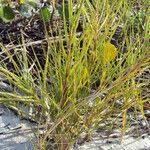Perennial with long, tough, yellowish rhizomes. Culms erect or decumbent, often fastigiately branched in upper part, 15–30 cm tall, 1–2 mm thick. Leaf sheaths tightly overlapping, loosely pubescent at mouth; leaf blades glaucous, stiff, distichous, flat at first, soon involute, 3–10 × 0.1–0.3 cm, adaxial surface scabrid, abaxial surface smooth, apex pungent; ligule ca. 0.2 mm. Panicle linear, spikelike, 3–10 × 0.4–1 cm; branches 0.5–1.5 cm, erect, appressed to rachis. Spikelets gray-green or greenish yellow, fusiform, 2.3–2.7 mm; glumes acute; lower glume lanceolate, 2/3–4/5 spikelet length, 1-veined; upper glume narrowly ovate, as long as spikelet, 1-veined; lemma broadly lanceolate, subequal to upper glume, midvein distinct, lateral veins obscure, obtuse; palea equaling lemma. Anthers 3, 1–1.5 mm. Grain subglobose, ca. 0.7 mm. Fl. and fr. Jun–Sep. 2n = 18.
Extensively creeping, tough, wiry perennial with hard scaly rhizomes; culms slender to rather stout, 50-70 cm., or even as much as 1 m., long, with short inter-nodes; sheaths glabrous; blades conspicuously distichous, mostly 8-12 cm. long, 3-5 mm. wide at the base, very firm, becoming loosely rolled or involute, gradually narrowed to a rather fine but firm point; panicles densely spike-like, 6-10 cm. long, 0.5-1 cm. thick, usually partly enclosed in the sheath; spikelets 2.5 mm. long, rarely longer;-glumes acute, subequal, the second as long as the spikelet, the first a little shorter.
Mat-forming perennial, 110-770 mm high; rhizomes extensively creeping; stoloniferous. Leaf blade 50-150 x 1-7 mm, convolute and pungent; ligule a fringed membrane or a fringe of hairs. Inflorescence a spike-like panicle, branches not whorled. Spikelets 1.7-2.5 mm long, laterally compressed, awnless, glabrous, disarticulating above glumes; glumes 1-nerved, lower glume 3/4 as long as spikelet; upper glume as long or slightly longer than spikelet. Floret 1; lemma similar in texture to glumes, membranous, often shining, 1-3-nerved. Flowering time Oct.-Apr.
Perennial from long creeping rhizomes; culms erect, 1.5–6 dm; lvs conspicuously distichous; sheaths overlapping; blades spreading or ascending, 5–8 cm, broadest (3–6 mm) near the base and tapering to a fine point; panicle exsert, 3–8 cm, stramineous or purplish; glumes sharply acute, the first 1.6–2.9 mm, the second 1.9–2.9 mm; lemma 1.9–2.8 mm, ca equaling the palea; 2n=18, 30. Sandy or muddy shores and marshes, usually in saline soil; trop. Amer., n. along the coast to se. Va.
Mat-forming perennial 110-770 mm high; rhizomes extensively creeping; stolons present; leaves cauline. Leaf blade 50-150 x 1-7 mm, convolute, pungent. Inflorescence 6-7 mm wide, spike-like, branches not whorled. Spikelet 1.7-2.5 mm long; glumes unequal, apices acute; lower glume 2/3-3/4 as long as spikelet; upper glume as long to slightly longer than spikelet; lemma ovate-elliptic; anther 1.2-1.5 mm long.
Mat-forming perennial, stoloniferous or rhizomatous (rhizomes extensively creeping), up to 0.77 m high. Leaf blades 50-150 mm long, 1-7 mm wide, convolute and pungent. Spikelets 1.7-2.5 mm long. Panicle spikelike, branches not whorled; lower glume three-quarters the spikelet length; upper glume as long or slightly longer than spikelet.
Creeping, stoloniferous and rhizomatous perennial, up to 300 mm tall. Leaves linear, rolled, pungent; ligule a fringe of hairs. Inflorescence a dense, spike-like panicle, lower branches not whorled. Spikelets 1.7-2.5 mm long, awnless, glabrous, 1-flowered; glumes unequal, upper as long as spikelet.
A herb. It is a grass that keeps growing from year to year. It has slender underground stems or rhizomes. It grows 60 cm high. The flowers are in a dense panicle 5 cm long.
Creeping stoloniferous and rhizomatous perennial to 30 cm. Leaves linear, rolled, pungent. Spikelets in a dense, spike-like panicle.


